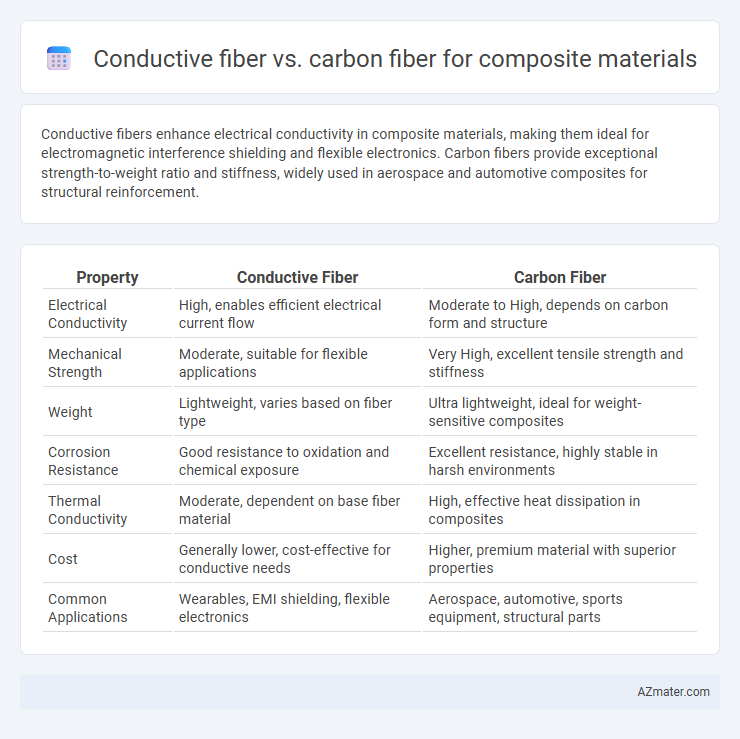Conductive fibers enhance electrical conductivity in composite materials, making them ideal for electromagnetic interference shielding and flexible electronics. Carbon fibers provide exceptional strength-to-weight ratio and stiffness, widely used in aerospace and automotive composites for structural reinforcement.
Table of Comparison
| Property | Conductive Fiber | Carbon Fiber |
|---|---|---|
| Electrical Conductivity | High, enables efficient electrical current flow | Moderate to High, depends on carbon form and structure |
| Mechanical Strength | Moderate, suitable for flexible applications | Very High, excellent tensile strength and stiffness |
| Weight | Lightweight, varies based on fiber type | Ultra lightweight, ideal for weight-sensitive composites |
| Corrosion Resistance | Good resistance to oxidation and chemical exposure | Excellent resistance, highly stable in harsh environments |
| Thermal Conductivity | Moderate, dependent on base fiber material | High, effective heat dissipation in composites |
| Cost | Generally lower, cost-effective for conductive needs | Higher, premium material with superior properties |
| Common Applications | Wearables, EMI shielding, flexible electronics | Aerospace, automotive, sports equipment, structural parts |
Introduction to Conductive and Carbon Fibers
Conductive fibers, typically made from materials such as silver, copper, or conductive polymers, offer excellent electrical conductivity and flexibility for integration into composite materials. Carbon fibers, composed primarily of carbon atoms arranged in a crystalline structure, provide exceptional mechanical strength, stiffness, and thermal stability while exhibiting moderate electrical conductivity. Both fiber types play crucial roles in advanced composites, with conductive fibers enhancing electrical properties and carbon fibers contributing superior structural performance.
Key Properties of Conductive Fiber
Conductive fibers offer exceptional electrical conductivity, making them ideal for applications requiring electromagnetic interference (EMI) shielding and static dissipation in composite materials. These fibers typically exhibit flexibility, lightweight characteristics, and compatibility with polymers, enhancing composite conductivity without compromising mechanical strength. Unlike carbon fibers, which are primarily valued for high tensile strength and stiffness, conductive fibers prioritize electrical performance while maintaining adequate durability for multifunctional composites.
Key Properties of Carbon Fiber
Carbon fiber offers exceptional tensile strength, lightweight characteristics, and high stiffness, making it ideal for composite material applications requiring durability and performance. Its excellent fatigue resistance and low thermal expansion contribute to structural stability under dynamic loads and varying temperatures. In contrast, conductive fibers prioritize electrical conductivity, but carbon fiber's balance of mechanical strength and moderate conductivity suits aerospace, automotive, and sports equipment industries.
Mechanical Strength Comparison
Conductive fibers typically offer moderate mechanical strength with enhanced electrical conductivity, making them suitable for multifunctional composite materials, while carbon fibers exhibit superior tensile strength, stiffness, and fatigue resistance, providing outstanding structural support in composites. Carbon fiber composites achieve tensile strengths ranging from 3,500 to 6,000 MPa, significantly higher than most conductive fibers, which often do not exceed 1,000 MPa. The mechanical performance of carbon fiber composites makes them the preferred choice for high-load-bearing applications, whereas conductive fibers are optimized for electrical functionality with acceptable strength for lighter structural demands.
Electrical Conductivity Analysis
Conductive fibers such as silver-coated or copper-based fibers exhibit superior electrical conductivity compared to carbon fibers, making them ideal for applications requiring efficient current flow. Carbon fibers, while offering moderate conductivity around 10^4 S/m, primarily contribute to mechanical strength and electromagnetic shielding rather than high electrical conduction. The choice between conductive fiber and carbon fiber in composite materials depends on balancing the electrical conductivity requirements with mechanical properties and cost constraints.
Applications in Composite Materials
Conductive fibers are primarily used in composite materials requiring electromagnetic shielding, antistatic properties, and enhanced electrical conductivity, making them ideal for aerospace, automotive, and wearable electronics. Carbon fibers offer superior strength-to-weight ratio and stiffness, widely applied in high-performance structural components such as aircraft frames, sporting goods, and automotive parts. The choice between conductive and carbon fibers depends on the required balance between electrical functionality and mechanical performance in composite applications.
Durability and Environmental Resistance
Conductive fiber composites exhibit excellent durability with superior resistance to fatigue and mechanical stress, making them ideal for long-term applications in harsh environments. Carbon fiber composites offer outstanding environmental resistance, particularly against UV radiation, moisture, and chemical corrosion, ensuring structural integrity over extended periods. Both materials enhance composite longevity, but carbon fiber's resistance to environmental degradation often surpasses that of general conductive fibers.
Cost Efficiency and Availability
Conductive fibers, typically made from materials like silver or stainless steel, offer moderate cost efficiency with easier availability compared to carbon fibers, which are premium-priced due to complex manufacturing and high demand in aerospace and automotive industries. Carbon fiber composites provide superior strength-to-weight ratio and electrical conductivity but require significant investment in production infrastructure, limiting access for budget-sensitive projects. For applications prioritizing cost efficiency and wide availability, conductive fibers present a practical alternative, while carbon fibers remain preferred for high-performance uses despite their higher expense.
Innovations and Future Trends
Conductive fiber composites enhance electromagnetic interference (EMI) shielding and smart textile applications through embedded metallic or carbon-based fibers, offering superior electrical conductivity and flexibility compared to traditional carbon fiber composites. Innovations in nanotechnology, such as the integration of graphene and carbon nanotubes, are driving advancements in strength-to-weight ratios, thermal conductivity, and multifunctional capabilities in both conductive and carbon fiber composites. Future trends emphasize sustainable production methods, hybrid composites combining conductive and carbon fibers, and enhanced recyclability to meet the evolving demands in aerospace, automotive, and wearable technologies.
Choosing the Right Fiber for Your Application
Conductive fibers offer excellent electrical conductivity and flexibility, making them ideal for applications requiring EMI shielding or smart textiles, whereas carbon fibers provide superior tensile strength and stiffness, suitable for structural components in aerospace and automotive industries. Selecting the right fiber depends on the application's primary needs--choose conductive fibers for electrical performance and carbon fibers for mechanical strength and weight reduction. Evaluating environmental factors, mechanical load requirements, and electrical functionality ensures optimal composite material performance and durability.

Infographic: Conductive fiber vs Carbon fiber for Composite material
 azmater.com
azmater.com